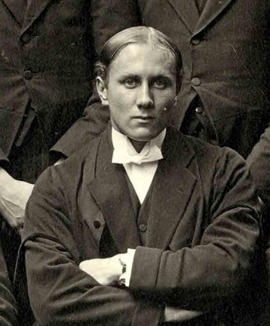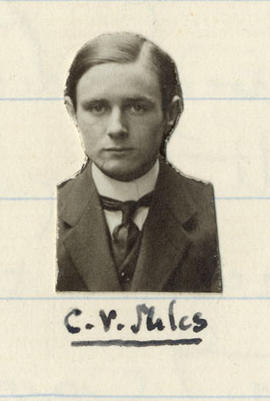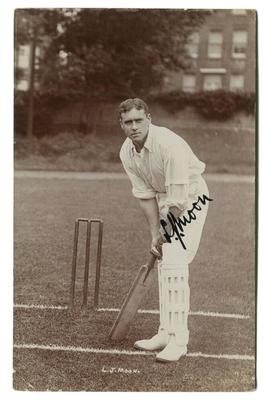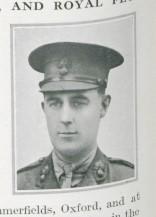McCulloch, John Wyndham Hamilton, only son of John Exley McCulloch, of Paddington; b. Dec. 4, 1894; adm. Sept. 23, 1909 (A); left July 1913; 2nd Lieut. 8th (Service) Batt. Border Regt. Nov. 4, 1914; Lieut. Feb. 27, 1915; temp. Capt.; d. Oct. 21, 1915, at Bailleul, of wounds received in action in Flanders the previous day.
Meeson, Edward Hickman Tucker, only son of Frederick Meeson, of Eastbourne, by his first wife, Emily, daughter of Frederic Andrews, of Binsted, Rants; b. Dec. 20, 1877; adm. April 24, 1890 (R); left April 1891; Asst. Eng. R.N. July 1, 1900; Eng.-Lieut. June 1, 1904; Eng.-Lieut.-Com. June 1, 1912; Eng.-Com. May 28, 1915; present at the action in the Heligoland Bight Aug. 28, 1914; D.S.O. Jan. 1, 1915; m. Dec. 28, 1908 Gladys May, elder daughter of George Robert Gordon Joy, of Kingston Hill, Surrey; killed in action at the battle of Horn Reef, off Jutland, May 31, 1916.
Mellor, Philip Evert McIlvaine, brother of Anthony Wright Camac Mellor (q.v.); b. Feb. 5, 1903; adm. May 2, 1917 (H); left July 1921; St. John's Coll. Camb., matric. Michaelmas 1921; played football (assoc.) against Oxford 1925; B.A. 1925; inspector, Sudan Plantations Syndicate Ltd., Oct. 1925; 2nd Lieut. Leicestershire Regt. May 11, 1940; transferred to 1st Batt. Parachute Regt. Aug. 1, 1942, and was one of the pioneers of parachuting; Capt.; M.C. Feb. 12, 1943; killed in action in North Africa, Feb. 1943.
Philip Evert McIlvaine Mellor was born at Kensington, London on the 5th of February 1903 the third and youngest son of Sir Francis Hamilton “Frank” Mellor Kt. BA LLB KC, a barrister at law and judge, and Lady Elizabeth Markoe (nee Camac) Mellor of 53, Victoria Road, Kensington in London and of “Woodvale”, Rotherfield Greys, Henley-on-Thames in Oxfordshire. He was christened at St Stephen’s Church, Kensington on the 14th of March 1903. He was educated at Westminster School where he was up Homeboarders from the 2nd of May 1917 to July 1921. He was a member of the 1st Cricket XI in 1921 and the Elizabethan wrote the following on his season that year: - “Bowls a good off break but does not vary his pace enough. A poor bat, because his left leg is never anywhere near the pitch of the ball; should make more use of his wrists and less of his forearms.” He was a member of the 2nd Football XI in 1919 and of the 1st Football XI from 1919 to 1921 where he played at left half. The Elizabethan wrote the following on his 1919/20 season: - “A splendid tackler, who never knows when he is beaten. Feeds his forwards well, but apt to give his passes too much in the air. Marks his wing man very closely, but might with advantage converge more into the centre when play is near his own goal.” They wrote the following on his 1920/21 season: - “A sound and reliable half back. But has the great fault of lying too far back and thus concentrating on defence to the entire exclusion of attack.” He was awarded School Colours for Football in 1921.
He matriculated for St John’s College, Cambridge in 1921 on a Marquess of Salisbury Exhibition and graduated with a BA in 1925. He was awarded a “Blue” for Association Football against Oxford in 1925. On leaving university he joined the staff of the Sudan Syndicate Ltd in October 1925, where he was appointed as an inspector.
He enlisted as a Private in the Scots Guards before attending the Officer Cadet Training Unit at the Royal Military College, Sandhurst from where he was commissioned as a 2nd Lieutenant in the Leicestershire Regiment on the 11th of May 1940. He transferred to the 1st Battalion, Parachute Regiment on the 1st of August 1942 where he was one of the pioneers of military parachuting.
In November 1942, the 1st Battalion, Parachute Regiment embarked for overseas service on board the passenger liner Arundel Castle and set sail from Clydeside. They disembarked at Algiers from where they marched to the airfield at Maison Blanche.
On the 16th of November 1942 the Battalion boarded aircraft at Maison Blanche and took off at 11am for an operation to capture the airfield at Souk-el-Arba which was thought to be held by Vichy French forces. It was not known whether the French would oppose the landing. The Battalion landed on the airfield at 1.30pm where they were met by a French officer and no opposition was met. At 5pm they formed up and mounted transport to move to Beja from where they mounted patrols over the next two weeks. On the 17th of November, S Company set out from Beja to the area of Sidi N’Sir from where they were to attack enemy outposts around Mateur. The following day they planned an ambush on an enemy column which had been seen at 7am that morning heading for Sidi N’Sir and was expected to return along the same route. The paratroopers were in position at 7.30am and at 10.30am the German column, which was made up of three eight wheeled armoured cars and three light reconnaissance cars, returned. Mines had been laid across the path of the returning vehicles and the paratroopers held their fire until the first vehicle struck a mine. Philip Mellor and his men rushed forward with Gammon bombs and quickly knocked out two of the armoured cars as well as two of the scout cars and killed their occupants. Those Germans who had not been killed or wounded in the first five vehicles surrendered without a fight and eight prisoners were taken.
At 8pm on the night of the 29th of November Philip Mellor led a patrol out along the Mateur Road to capture enemy prisoners for interrogation. As they advance on foot on either side of the road at 12.43am they came under fire from automatic weapons and a light machine gun from their left. They returned fire and threw grenades at the enemy who quickly fled back to their armoured car and left hurriedly. Mellor then sent half his men back to base and continued on with the other half. The patrol was three and a half miles from Mateur when they ran into an enemy road block. During an exchange of fire Philip Mellor’s helmet was perforated by a bullet but he was unharmed.
On the 1st of December 1942, the Battalion attacked enemy positions at Coxen’s Farm near Medjez-el-Bab. The following day a report was received that enemy troops were arriving in trucks on the Mateur Road and Philip Mellor’s Platoon was sent to investigate. When he and his men arrived there they met heavier opposition that had been expected and after a short fire fight, in which they suffered three casualties, they were forced to disengage. On the night of the 11th of December 1942, Philip Mellor led a patrol which attacked enemy 88mm gun positions. They killed a number of the enemy and returned with five prisoners.
For his actions since landing in North Africa he was awarded the Military Cross, which was announced by the War office on the 11th of February 1943. The recommendation for his award read as follows: - “For most conspicuous gallantry. Throughout all operations and actions between 17 Nov., and 24th Dec., Lieut. Mellor’s conduct has been an outstanding example to all ranks under his command and to the Battalion as a whole. On no less than four occasions he has displayed gallantry of the highest order and a total disregard for his own safety. On the morning of 18th Nov., an ambush was laid on the S’nsir – Mateur rd., to destroy a strong armoured patrol of the enemy. This officer led a strong group of bombers to attack the armoured vehicles. He attacked and immobilised one armoured vehicles, and destroyed and killed the occupants personally of one scout car at a range of about five yards. On the 29/30 Nov., Lieut. Mellor was in command of a fighting patrol which was ordered to raid enemy positions in Tunisia. The patrol encountered and destroyed an enemy section post. The patrol then withdrew and Lieut. Mellor went forward alone to within three miles of Mateur and brought back valuable information as to enemy dispositions on the road. On the 2nd December Lieut. Mellor was ordered to take two sections in carriers to attack enemy troops which were seen in the area of a farm. On arriving at the farm he attacked but was forced to withdraw owing to intense machine gun fire. On withdrawing under cover he found that one man was missing and without a thought for his own personal safety he returned and brought back the missing man. On the 10/11 Dec., Lieut. Mellor was in command of a fighting patrol which was ordered to attack and destroy an enemy A.A. gun position and bring back prisoners. He attacked the position and captured five prisoners and damaged the gun. The attack was made in the face of heavy machine gun fire and it was only by the personal courage and leadership of Lieut. Mellor that the post was taken and invaluable information obtained. On many different occasions Lieut. Mellor has taken part in long daylight reconnaissances in and behind the enemy positions & brought back information of extreme value concerning the enemy positions and by his courage & inspiration set an example of the highest order to all ranks.”
On the 3rd of February 1943, the 1st Battalion, Parachute Regiment was to attack enemy positions on two hills at Djebel Mansour. R and T Companies were to lead the attack with S Company in support. Once the position had been secured they would be relieved by the 3rd Battalion, Grenadiers Guards. As the two leading Companies began to climb the steep slopes in the dark it began to rain. They were following white tapes which had been laid to help them find their way in the dark. S Company, which was following, was also following the white tapes but, by the time they passed up the hills, the tapes had been cut and they headed off in the wrong direction.
R and T Companies managed to get very close to the enemy positions without being spotted and then rushed them at the point of the bayonet. After heavy hand to hand fighting they had secured both of the positions of Djebel Mansour and Djebel Alliliga. Meanwhile, S Company had run into a minefield where it is thought that Philip Mellor had trodden on a mine as he was seen to have lost a leg and to have been wounded by machinegun fire. The Company continued on and launched its attack. Philip Mellor was last seen crawling towards the enemy machine guns firing his pistol and it was reported that when his body was recovered it had seventeen bullet wounds. He was buried where he fell but the site was lost in the subsequent fighting.
Sergeant Eric Seal of S Company later wrote of the fighting: - “In the battle for Djebel Mansour, S Company suffered very heavy casualties, including Lieutenant Mellor who was killed attacking a machine gun post, which was typical of the man; thus died an irreplaceable soldier.”
He is commemorated on the war memorial at St John’s College, Cambridge.
He is commemorated on the Medjez-el-Bab Memorial Face 34.
Meyer, Edward Stirling, son of William Charles Bernhard Meyer MD FRCS and Alice Elizabeth Stirling, writer, d. of Col. Alexander Surlmg, Black Watch, of Perth; b. 8 Dec. 1920; adm. Sept. 1933 (KS); Capt. of the school 1938-9; left July 1939; Ch. Ch. Oxf., matric. 1939; Black Watch 1941-4 (Capt.), wounded, despatches (Middle East) Jan. 1944; killed in action (NW Europe) 1944.
Edward Stirling Meyer was born at Marylebone, London on the 8th of December 1920 the elder son of Dr William Charles Bernard Meyer BA MB Ch.B FRCS, a surgeon, and Alice Elizabeth (nee Stirling) Meyer MA, a writer, of 215, North End Road, West Kensington in London. He was educated at the Froebel Institute, Westminster and at Westminster School where he was admitted as a King’s Scholar from September 1933 to July 1939. He was awarded the Science VI Form Prize in 1936. He was a member of the Cricket XI in 1938 and 1939 and was a member of the Rowing VIII in 1939. He was a member of the Eton Fives team from 1937 and was a member of the First Pair in 1938 and 1939 and served on the Committee of the Debating Society in 1938. He was elected as Captain of Gym in 1938 and was a member of the Squash team in the same year. He was a member of the Officer Training Corps and was promoted to Lance Corporal in September 1937. He was Captain of School from 1938 to 1939. He won the Westminster Scholarship to Christ Church, Oxford and matriculated in 1939. He did not complete his degree as he left the College for military service.
He was commissioned as a 2nd Lieutenant in the Black Watch (Royal Highlanders) on the 12th of March 1941 and was promoted to temporary Captain on the 13th of January 1944. He was wounded in the Middle East in 1943 and was Mentioned in Despatches for: -“Gallant and distinguished services in the Middle East”, which was announced by the War Office on the 13th of January 1944.
At 8am on the morning of the 10th of June 1944, the 7th Battalion, Black Watch arrived off the Normandy beaches at Courseulles-sur-Mer and began unloading at 6am the following morning. On the 20th of June 1944, the Battalion relieved the 3rd/7th Gordon Highlanders at the Bois de Bavent. They occupied the positions in the thick woodland where they were under sniper fire and they came under shell fire during the afternoon. The following day enemy patrols probed their positions and they were subjected to further shelling. On the 22nd of June, they came under heavy shell and mortar fire throughout the day and suffered casualties of two men killed and six wounded. On the 23rd of June, B Company was approached by an enemy tank which was repelled and later, the Regimental Aid Post received a direct hit from an enemy shell which killed three men. That afternoon Edward Meyer lead a patrol out towards the German lines to a position known as “Timber Post”, to the east of the Battalion’s positions, where he heard an enemy working party, but did not engage them before returning to the woods.
On the 26th of June 1944, the Battalion was relieved by the 7th Battalion, Argyll and Sutherland Highlanders and was to move to Escoville. At noon, during the relief, heavy shelling and mortar fire fell on their positions and Edward Meyer was killed by the explosion of a mortar shell. Two other men were killed and four more were wounded.
The Westminster School magazine, The Elizabethan, wrote of him: - “He was a boy of all-round ability, and conspicuous among his qualities was the indomitable courage and determination by which he triumphed over an almost excessive natural shyness and over disappointments resulting from ailments and accidents. He was training for the medical profession, but threw it up to join the fighting services.”
He is buried at La Delivrande War Cemetery Plot V, Row A, Grave 6.
Miles, Alfred Crosfield Vernor, brother of Cyril Vernor Miles (q.v.); b. Aug. 31, 1894; adm. Sept. 24, 1908 (G); K.S. (non-resident) 1909; left July 1913; articled to his father Sept. 1913; enlisted in 1st Batt. Artists' Rifles Aug. 1914; 2nd Lieut. 2nd Batt. Welsh Regt. April 23, 1915; went out to the western front Oct. 1914; killed while acting as Brigade Wiring Officer, near Vermelles, in France, Aug. 24, 1915; unm.
Miles, Cyril Vernor, second son of Edward Vernor Miles, of Hampstead, solicitor, by Gertrude, daughter of Alfred Crosfield, of Liverpool; b. Aug. 5, 1892; adm. Sept. 28, 1905 (G); left July 1911; Pembroke Coll. Camb., matric. 1911; 2nd Lieut. 3rd Batt. (Res.) South Wales Borderers Aug. 15, 1914; attached Welsh Regt. Feb. 15, 1915; Capt. July 29, 1915; went out to the western front March 1915; killed in action at Hulloch, near Loos, Sept. 26, 1915; unm.
Montefiore, Langton, brother of Leslie Montefiore (q.v.); b. April 6, 1904; adm. Sept. 26 1918 (A); left Easter 1922; admitted a member of the London Stock Exchange 1927; 2nd Lieut. R.A.S.C. March 30, 1940; Capt.; m. June 2, 1927, Millicent, daughter of S. Lazarus, of St. Marylebone; killed on active service in Greece 27 April 1941.
Langton Montefiore was born at Chartridge, Buckinghamshire on the 6th of April 1904 the second son of Harry John Montefiore, a stockbroker and member of the London Stock Exchange, and Harriet (nee Montefiore) Montefiore of Chartridge Grange, near Chesham, later of “Fingest”, near Henley-on-Thames in Oxfordshire.
He was educated at Westminster School where he was up Ashburnham from the 26th of September 1918 and Easter 1922. He was a member of the Debating Society in 1921. He was a member of the Officer Training Corps and was promoted to Corporal in September 1921. On leaving school he went to work as a stockbroker and was admitted as a Member of the London Stock Exchange in 1927. He was married at Marylebone on the 2nd of June 1927 to Millicent (nee Lazarus) and they lived at 80, Eaton Place in London and at “Valley Holme”, Horsted Keynes in Sussex. They had a son, born on the 6th of May 1928. Following the outbreak of war he was appointed as a Deputy Area Officer for Air Raid Precautions. He was commissioned as a 2nd Lieutenant in the Royal Army Service Corps on the 30th of March 1940.
At 7pm on the 24th of April 1941, a convoy of trucks of the 308th Reserve Motor Transport Company, Royal Army Service Corps left Argos, Greece to head for Kalamata where they were to be evacuated to Egypt following the collapse of the Allied resistance to the German invasion of Greece. Driver T/199458 F.G. Lee reported that Major James Garrard Black, 2nd Lieutenant J.M. Carroll Lieutenant Mansfield, Langton Montefiore and about 100 men were among those who remained at Argos from where they made their way to the beaches in Nauplia Bay to await evacuation to Crete. They boarded the 11, 636 ton passenger liner SS Slamat, under the command of Master Tjalling Luidinga, on the night of the 26th/27th of April and set sail at 4.15am on the 27th of April. SS Slamat sailed south as part of a convoy and was in the Argolic Gulf when the convoy was attacked firstly by Messerschmitt Bf109 fighters and then by Junkers 87, Junkers 88 and Dornier 17 bombers at 7.15am. During the attack SS Slamat was struck between the bridge and the forward funnel by a 550lb bomb and was set on fire. As she listed to starboard, she was hit by a second bomb and the order was given to abandon the ship. With many of life boats and life rafts having been destroyed in the bombing, most of the survivors swam clear of the sinking ship with two overcrowded life boats capsizing. Some of the survivors were machine gunned in the water by enemy fighters. The destroyer HMS Diamond began taking survivors on board but was forced to stop and speed away when she too came under attack from enemy aircraft. HMS Diamond returned at 8.15am to rescue more survivors and at 9.16am the destroyer HMS Wryneck was ordered to join her in the rescue of the men in the water. At 9.25am HMS Diamond reported that she had picked up most of the survivors and was heading for Souda Bay but, when HMS Wryneck joined HMS Diamond at 11am both of the destroyers returned to SS Slamat where they found two more lifeboats and rescued their occupants. With SS Slamat on fire from stem to stern, she was scuttled by HMS Diamond with a single torpedo before the destroyer left the area with around 600 survivors on board. It is believed that Langton Montefiore was among those who were rescued from the water by the two destroyers.
At 1.15pm, a formation of Junkers 87 “Stuka” dive bombers attacked the two destroyers from out of the sun,with two bombs landing on HMS Diamond destroying her lifeboats and she sank eight minutes later. HMS Wryneck was hit by three bombs and sank ten to fifteen minutes later.
About 1,000 men were lost in the bombing of the three ships with only eight from the five hundred evacuees on board SS Slamat surviving the sinkings.
He is commemorated on the Athens Memorial Face 8.
Moon, Leonard James, brother of William Robert Moon (q.v.); b. Feb. 9, 1878; adm. May 8, 1891 (G); left July 1896; Pembroke Coll. Camb., matric. Michaelmas 1896; B.A. 1900; M.A. 1912; played football (assoc.) for Cambridge 1898-1900, and cricket 1899 and 1900; played cricket for Middlesex 1899 and 1900, and for England v. S. Africa 1905; Head Master of Wellesley House School, Broadstairs, Kent; enlisted in the Inns of Court O.T.C.; 2nd Lieut. 10th (Serv.) Batt. Devon Regt. Feb. 10, 1915; served in France; d. Nov. 23, 1916, of wounds received at Salonika, Greece.
Morgan, Albert Ernest, only son of Albert Charles Frederick Morgan, of Bayswater; b. May 24, 1889; adm. Sept. 25, 1902 (G); left July 1905; 2nd Lieut. 6th Batt. (Spec. Res). Royal Fusiliers May 22, 1911; Lieut. June 29, 1913; Flying Officer R.F.C. Sept. 12, 1914; asst. instructor at Upavon, Royal Flying School; went out to the western front Dec. 30, 1914; killed near Neuve Chapelle, France, in an aeroplane brought down by shell-fire March 10, 1915.
Morrall, Edgar Percy Basil, only son of Lieut.-Col. Abel Edgar Morrall, South Wales Borderers, by Annie, only daughter of George Townsend; b. Aug. 9, 1884; adm. April 23, 1896 (A); left July 1897; Lieut. Border Regt. Oct. 14, 1914; Capt. 9th Serv. Batt. (Pioneers) Feb. 23, 1915; acting Major; went out to the western front in 1915, thence to Serbia; invalided from Salonika and returned to England Aug. 1916, went out again to the western front early in 1917; m. Rose Ethel, daughter of John Macdonough, M. D., of Killarney, Ireland; killed in action near Arras, France, July 28, 1917.




